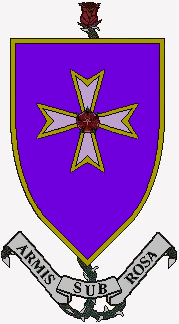
|
Ceremonies and Protocol: The Accolade
Ritual and
ceremony are very important aspects in the life of an assembly or group of
people gathered in common cause. Its
symbolism evokes an emotional attachment.
In respect of the ancient rites of knighthood, this Order encourages
historically accurate ceremonies of worship, induction, and promotion.
Induction
ceremonies should, as and when possible, replicate ancient rites of
knighthood. A vigil or vigil service
should be held in a Christian place of worship, followed the next day with a
ceremony of induction.
For the purpose of clarification and definition, the Knight Commander authorized to
induct a new postulent will be called "Delegate", as they represent
the Grand Master in a role of delegated authority. In most cases, this Knight Commander will be the Master of a
Grand Priory of the Order. A
"Postulent" is a Squire or Lady in Waiting, an individual deemed
worthy who is about to be inducted as a new member of the Order.
The
postulent will respond to questions put to them by the Delegate, declaring in
the process their faith and vows of knighthood. If they have a surcoat representing their own legitimate arms or
the colours of the Order, and have purchased a medieval sword and double-wrap
sword belt, they can be belted as part of the ceremony after receiving their
accolade.
After satisfying the Delegate with
their vows, the postulent will kneel on a pillow, with one or both knees, and
will bow their head. The Delegate will
be handed a sword by a Marshal or Standard Bearer which they will then use to
dub the postulent.
If the postulent agrees beforehand
to accepting a light blow, the Delegate will lightly but firmly tap them on one
side of the neck or cheek with either their hand or the broad of the
blade. They will then place the blade
gently on one should and make the following declaration:
"I dub
thee a knight / dame of the rose.
Rise Sir Knight /
Rise Dear Lady."
The postulent will rise and, if they are being belted, they will raise their arms over their head and the sword and belt will be buckled about them. The assisting knight will then help them put their mantle on.
The blow on the neck or cheek is the actual accolade. It was, in actual fact, the last time a knight.
Others Matters of Ceremony
Knights of the Rose will wear black capes for high ceremonies. They may also wear a complete crusader costume for parades, representing the 12th or 13th century, with a white surcoat charged with a purple cross bordered with gold. A cape-pin of the Order is being designed for use as an appropriate decoration.
The Maltese cross as described for the charge on the shield is referred to as the "Cross of Honour", and variances of its design will be used as badges for wear by members. For brevity, the Knight's Cross is also the Dame's Cross.
Knight's Cross:
Knights of the Order will wear a Cross of Honour, gold with lavender
enamel, below their left breast or pocket.
They may wear a neck cross of similar design with a gold heraldic rose
in its center. Members will wear
a red neck ribbon. Officers will wear a purple neck ribbon. Commanders will wear a purple neck ribbon bordered in yellow-gold. Master Knights and Grand Dames will be distinguished
by their mantle; black with purple satin lining.
![]()
